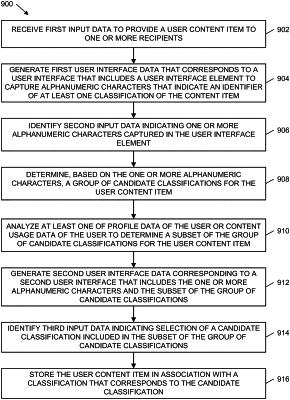| CPC G06F 16/9535 (2019.01) [G06F 3/0482 (2013.01); G06F 2218/12 (2023.01)] | 20 Claims |

|
1. A method comprising:
receiving, by a computing system including one or more computing devices that each include a processor and memory, first input data to provide a content item to one or more recipients, the content item including at least one of image content or video content captured via a client application, wherein the content item is associated with an account of a user of the client application;
generating, by the computing system, first user interface data that corresponds to a user interface that includes a user interface element to capture alphanumeric characters that indicate an identifier of at least one classification of the content item;
identifying, by the computing system, second input data indicating one or more alphanumeric characters captured in the user interface element, wherein the one or more alphanumeric characters correspond to a partially completed classification;
determining, by the computing system, that the one or more alphanumeric characters of the partially completed classification satisfy a threshold number of alphanumeric characters;
responsive to determining that the one or more alphanumeric characters satisfy the threshold number of alphanumeric characters, determining, by the computing system and based on the one or more alphanumeric characters of the second input data, a group of candidate classifications for the content item;
analyzing, by the computing system, at least one of profile data of the user or content usage data of the user to determine a subset of the group of candidate classifications for the content item;
generating, by the computing system, second user interface data corresponding to a second user interface that includes the one or more alphanumeric characters and the subset of the group of candidate classifications;
receiving, by the computing system, third input data indicating selection of a candidate classification included in the subset of the group of candidate classifications; and
storing, by the computing system, the content item in association with a classification that corresponds to the candidate classification.
|